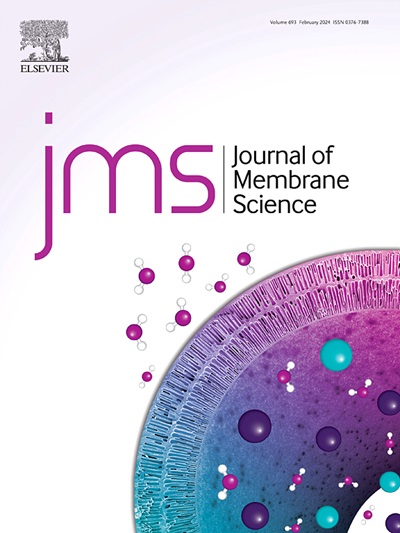Preparation of high-permeance polyester nanofiltration membranes utilizing biobased phloretin derivatives for antibiotic separation
IF 8.4
1区 工程技术
Q1 ENGINEERING, CHEMICAL
引用次数: 0
Abstract
Antibiotics in water bodies pose a significant threat to the health of plants, animals, and humans, thereby contributing to severe ecological crises. Polyamide nanofiltration (NF) membranes are extensively employed for the separation and purification of antibiotics but are limited by relatively low permeation fluxes. In this study, three biobased phloretin derivatives—phloretin (Pt), phlorizin (Pz), and naringenin dihydrochalcone (Ng), were selected as water-phase monomers and reacted with trimesoyl chloride to fabricate three novel polyester NF membranes. The results demonstrated that the variations in the molecular structure gradients, including twisted conformation and molecular weight, of the three derivatives significantly influenced the structure and properties of polyester NF membranes. In-depth mechanistic analysis revealed that the diffusion rates (mainly related to molecular weight) of the three derivatives into the oil-phase solution, rather than their reactivity with TMC, governed the interfacial polymerization (IP) process. Consequently, Pt-based polyester NF membranes exhibited relatively dense layers compared to Pz- and Ng-based ones, achieving rejections of 92.4 % and 85.7 % for bacitracin and erythromycin, respectively, while maintaining a permeance of 35.2 L/m2 h bar, which was significantly higher than that of conventional polyamide NF membranes. Meanwhile, the relatively loose structure of the Pz- and Ng-based polyester NF membranes made their permeance reach as high as 65.8 L/m2·h·bar and 107.2 L/m2 h bar, respectively, while maintaining intermediate separation level for five antibiotic molecules. Furthermore, the three polyester NF membranes demonstrated excellent chlorine resistance, antifouling properties, and good environmental adaptability. The three biobased polyester NF membranes in this study offer a novel approach for the development of high-flux NF membranes for antibiotic separation and other specialized scenarios. The correlation between the molecular structure of the derivatives and the membrane separation performance further deepens the understanding of polyester-based IP theory.

利用生物基根皮素衍生物制备高渗透聚酯纳滤膜用于抗生素分离
水体中的抗生素对植物、动物和人类的健康构成重大威胁,从而造成严重的生态危机。聚酰胺纳滤(NF)膜广泛用于抗生素的分离和纯化,但其渗透通量相对较低。本研究以三种生物基根皮素衍生物——根皮素(Pt)、根皮素(Pz)和柚皮素二氢查尔酮(Ng)为水相单体,与三甲基氯反应制备了三种新型聚酯纳滤膜。结果表明,三种衍生物的分子结构梯度(包括扭曲构象和分子量)的变化对聚酯NF膜的结构和性能有显著影响。深入的机理分析表明,三种衍生物在油相溶液中的扩散速率(主要与分子量有关),而不是它们与TMC的反应性,决定了界面聚合(IP)过程。因此,与Pz和ng基相比,pet基聚酯NF膜具有相对致密的层数,对杆菌素和红霉素的拒绝率分别为92.4%和85.7%,同时保持了35.2 L/m2 h bar的通透性,显著高于常规聚酰胺NF膜。同时,Pz基和ng基聚酯纳滤膜相对疏松的结构使其透过率分别高达65.8 L/m2·h·bar和107.2 L/m2·h bar,同时对5种抗生素分子保持中间分离水平。此外,这三种聚酯纳滤膜具有优异的耐氯性、防污性和良好的环境适应性。本研究的三种生物基聚酯纳滤膜为开发用于抗生素分离和其他特殊情况的高通量纳滤膜提供了一种新的途径。衍生物的分子结构与膜分离性能之间的相关性进一步加深了对基于聚酯的IP理论的理解。
本文章由计算机程序翻译,如有差异,请以英文原文为准。
求助全文
约1分钟内获得全文
求助全文
来源期刊

Journal of Membrane Science
工程技术-高分子科学
CiteScore
17.10
自引率
17.90%
发文量
1031
审稿时长
2.5 months
期刊介绍:
The Journal of Membrane Science is a publication that focuses on membrane systems and is aimed at academic and industrial chemists, chemical engineers, materials scientists, and membranologists. It publishes original research and reviews on various aspects of membrane transport, membrane formation/structure, fouling, module/process design, and processes/applications. The journal primarily focuses on the structure, function, and performance of non-biological membranes but also includes papers that relate to biological membranes. The Journal of Membrane Science publishes Full Text Papers, State-of-the-Art Reviews, Letters to the Editor, and Perspectives.
 求助内容:
求助内容: 应助结果提醒方式:
应助结果提醒方式:


